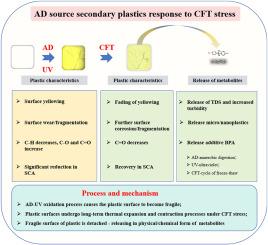Secondary degradation of anaerobic-digested and UV-pretreated plastics under cycles of freeze-thaw
IF 7.3
2区 环境科学与生态学
Q1 ENVIRONMENTAL SCIENCES
引用次数: 0
Abstract
Cycle of freeze-thaw (CFT) is a typical environmental characteristic in cold regions during the transition from winter to spring, which may drive physical stress acting on the plastics. This study investigated the impacts of CFT on the changes to polyvinyl-chloride (PVC) and polylactic acid (PLA) plastic-film surface, sourced from anaerobic digestion (AD) and AD + UV exposure. The findings showed that under the action of AD+UV, the surface of PVC and PLA plastic-film became yellow, fragile and rough. The consequent CFT process reduced surface yellowing and abundance of oxygen-containing groups on plastic-surface increased during AD and UV exposure, as well as impelled the PLA plastic-film fragmentation. The hydrophobicity of the plastic-film surface was compromised by AD and UV treatment, with partial restoration observed after CFTs. The phenomenon could be attributed to CFT stress stripping away the fragile oxidized surface layer of the plastic-film, as evidenced by the presence of micro/nanoplastics as well as the detection of total dissolved solids (TDS), plastic-additive bisphenol A and increased turbidity in the CFT extracts. The study highlights that CFT stress may be a significant yet often overlooked environmental process that influences the environmental degradation of "organic fertilizer source" plastics.


厌氧消化和紫外线预处理塑料在冻融循环下的二次降解
冻融循环(CFT)是寒区冬春交替过程中典型的环境特征,它会驱动作用在塑料上的物理应力。本文研究了CFT对厌氧消化(AD)和AD +紫外线照射下聚氯乙烯(PVC)和聚乳酸(PLA)塑料薄膜表面变化的影响。结果表明:在AD + UV作用下,PVC和PLA塑料薄膜表面变黄、变脆、变粗糙;随后的CFT处理减少了AD和UV照射下塑料表面的黄变,增加了塑料表面含氧基团的丰度,并促进了PLA塑料薄膜的断裂。塑料薄膜表面的疏水性受到AD和UV处理的损害,在CFTs后观察到部分恢复。这一现象可归因于CFT应力剥离了塑料薄膜脆弱的氧化表面层,微/纳米塑料的存在以及CFT提取物中总溶解固体(TDS)、塑料添加剂双酚A (BPA)和浊度增加的检测证明了这一点。该研究强调,CFT应力可能是影响“有机肥源”塑料环境降解的一个重要但经常被忽视的环境过程。
本文章由计算机程序翻译,如有差异,请以英文原文为准。
求助全文
约1分钟内获得全文
求助全文
来源期刊

Environmental Pollution
环境科学-环境科学
CiteScore
16.00
自引率
6.70%
发文量
2082
审稿时长
2.9 months
期刊介绍:
Environmental Pollution is an international peer-reviewed journal that publishes high-quality research papers and review articles covering all aspects of environmental pollution and its impacts on ecosystems and human health.
Subject areas include, but are not limited to:
• Sources and occurrences of pollutants that are clearly defined and measured in environmental compartments, food and food-related items, and human bodies;
• Interlinks between contaminant exposure and biological, ecological, and human health effects, including those of climate change;
• Contaminants of emerging concerns (including but not limited to antibiotic resistant microorganisms or genes, microplastics/nanoplastics, electronic wastes, light, and noise) and/or their biological, ecological, or human health effects;
• Laboratory and field studies on the remediation/mitigation of environmental pollution via new techniques and with clear links to biological, ecological, or human health effects;
• Modeling of pollution processes, patterns, or trends that is of clear environmental and/or human health interest;
• New techniques that measure and examine environmental occurrences, transport, behavior, and effects of pollutants within the environment or the laboratory, provided that they can be clearly used to address problems within regional or global environmental compartments.
 求助内容:
求助内容: 应助结果提醒方式:
应助结果提醒方式:


